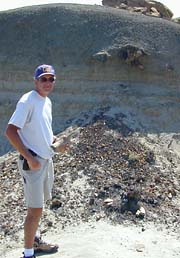|
|
||
|
| ||
|
Mark Goodwin juggles a suite of challenging roles and responsibilities. In addition to overseeing the UCMP collections, he manages a diverse research program.
Goodwin studies how bones develop as dinosaurs mature and how fossil bone is preserved. His interest in these topics has evolved over the course of twenty years of museum and field work in vertebrate paleontology. He works primarily on two groups of dinosaurs, the three-horned Triceratops and the dome-headed pachycephalosaurs. He is interested in how the unusual shapes of these dinosaurs’ skulls change as the dinosaur grows towards adulthood. These growth patterns may provide important clues about evolutionary relationships among certain dinosaur groups. Another major line of research may have important implications as to how fossilized bone is used to provide information about dinosaur biology and behavior. This work examines the chemistry of bone as it changes during fossilization. Goodwin and his collaborators suggest that paleontologists should look more closely at the trace elements and chemical composition of fossil specimens, and how these values compare with modern bone (alternations that occur to bone after death are called diagenesis). The effect of the burial environment on fossilization and stable isotope analysis is another area Goodwin is investigating.
– Learn more about Goodwin’s collaborative research on dinosaur bone diagenesis. |
|
| Browse the Interview: Profile | Research | Path to UCMP | Life at UCMP | ||
| Home | What’s new | About UCMP | History of life | Fossil collections | Other resources | ||
